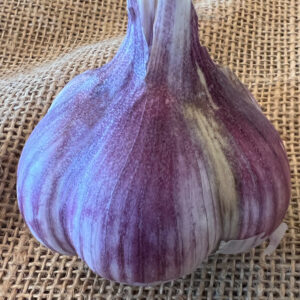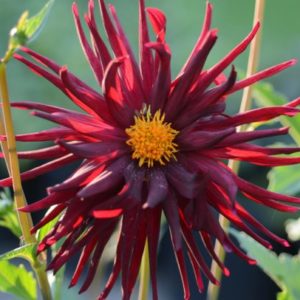Description
 Porcelain Garlic, Romanian Red
Porcelain Garlic, Romanian Red
GARLIC, which is a member of the same group of plants as the ONION, has been cultivated for millennia. As a cultivated plant, it is so old that it is difficult to credit a country of origin for this vegetable. Some historians believe that onions and garlic was indigenous to the southwest of Siberia and spread to southern Europe where it became naturalized. It is widely grown in all the Mediterranean countries.
All modern garlic belongs to one of two subspecies: hardneck (ophioscorodon) or softneck (sativum). Hardneck subspecies try to produce flower stalks with small aerial cloves called bulbils. Hardnecks will not produce large bulbs underground unless the flower stalks are removed. There are seven varieties of hardneck garlic: Asiatics, Purple Striped, Glazed Purple Stripe, Marbled Purple Stripe, Porcelain, Turban and Rocambole. Softnecks have lost the ability, for the most part, to produce a flower stalk. However, under certain climatic situations, the bulbs may try to produce a flower stalk known as bolting. There are four varieties of softneck garlic: Artichoke, Turban, Silverskin and Creole.
Porcelains are a truly remarkable family of garlic cultivars and, until recently, were virtually unknown in the United States.
Porcelain Garlics are hardnecks. Most varieties have pure white skins and cloves so large that they are often mistaken for elephant garlic. The individual cloves are usually crystal white, hence the name Porcelain. One pound of bulbs averages 40 plants. Porcelain Garlics produce the tallest plants of all garlic cultivars. Some Porcelain plants can reach a height of 7 feet.
Each bulb contains 4-6 giant cloves with 4 cloves being the norm. The cloves are arranged in a single layer – no small interior cloves and the cloves are easy to peel. Unlike most hardnecks, Porcelains are fairly good storers.
The plants are very, very cold hardy, flourishing in Hardiness Zones1-4, but surprisingly the Porcelains also grow well in warmer climates. Porcelains, more than any other garlic cultivars, are extremely sensitive to spring growing conditions. This means that in the spring, to perform at their best, Porcelains need cool temperatures and abundant moisture. At harvest time, with most garlic, dry conditions help the garlic bulbs to finish well. With Porcelains, during harvest time it is recommended to expose the plants to moist conditions in order to help them to finish well.
Finally and perhaps most significantly, the Porcelains produce the highest yields of allicin, the sulfur compound which is most directly associated with garlic’s therapeutic benefits.











